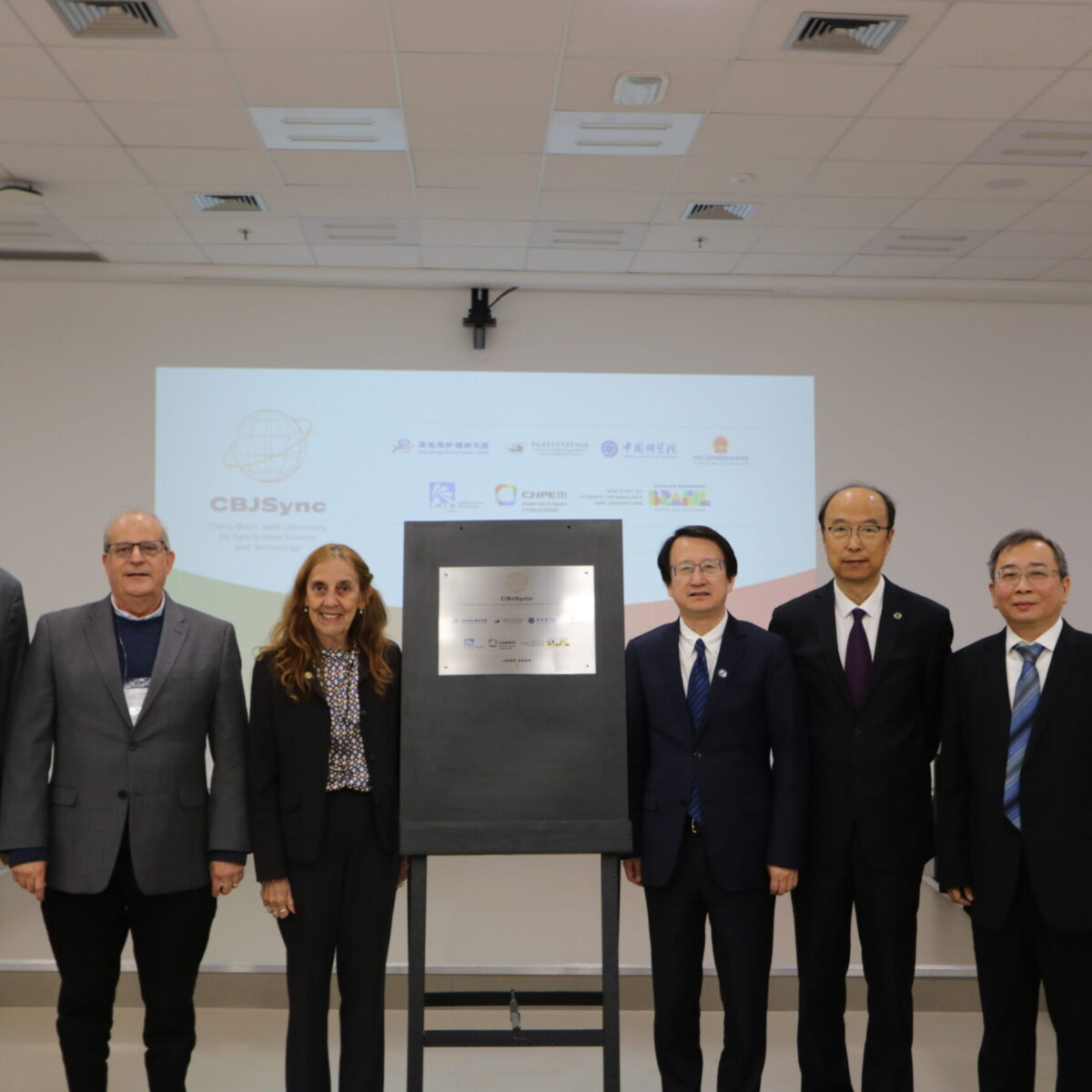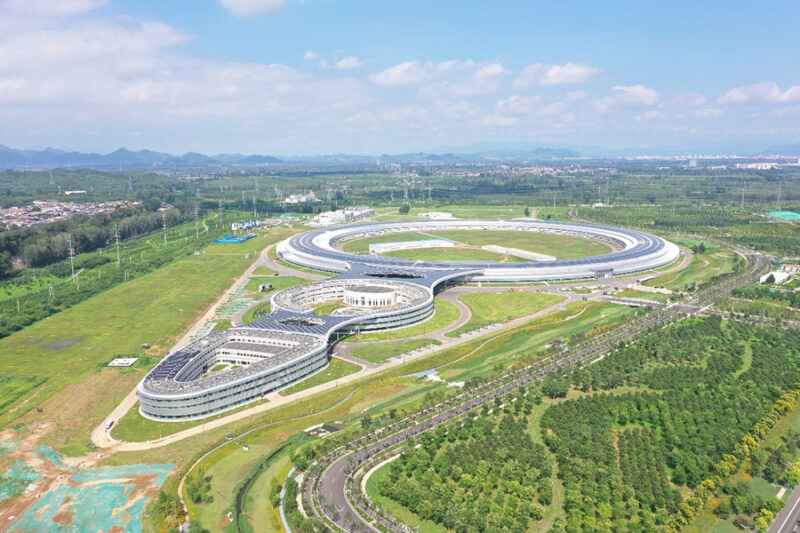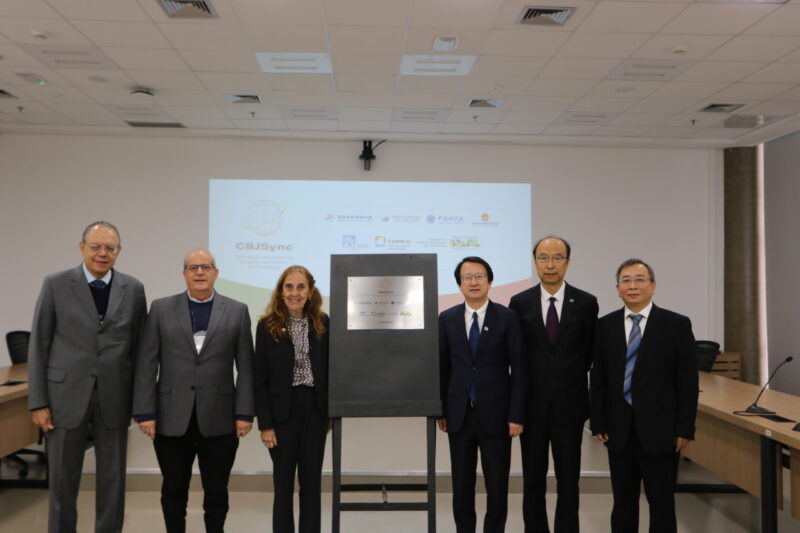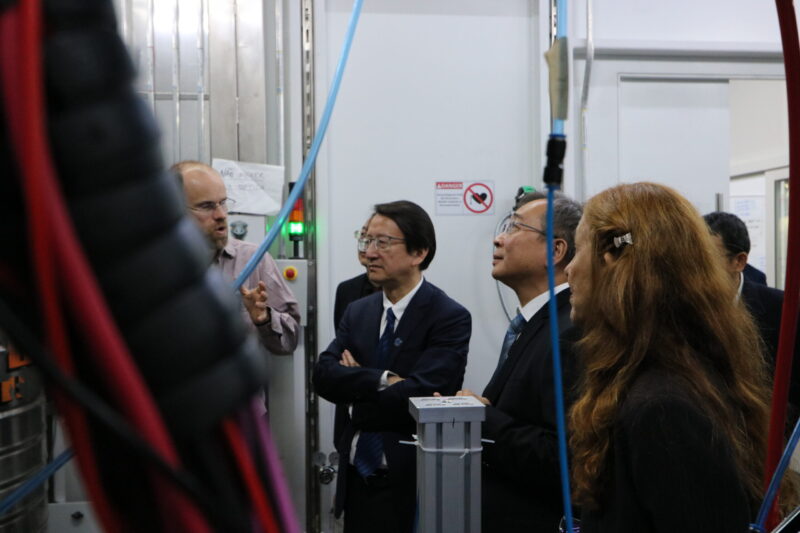
Members of the Chinese Academy of Sciences, members of IHEP, Brazilian Ministry of Science, Brazilian Academy of Sciences and CNPEM during the ceremony held on June 25, 2025, in Campinas, São Paulo.
Initiative strengthens scientific cooperation between Brazil and China in synchrotron light research and marks the beginning of researcher exchanges
The Brazilian Center for Research in Energy and Materials (CNPEM), a non-profit organization supervised by Brazil’s Ministry of Science, Technology and Innovation (MCTI), and the Institute of High Energy Physics (IHEP) of the Chinese Academy of Sciences (CAS) jointly inaugurated the China-Brazil Joint Laboratory for Synchrotron Science and Technology (CBJSync) on June 25, 2025. The initiative marks the beginning of in-person scientific exchange, with Chinese researchers working at the CNPEM campus in Campinas, São Paulo, and Brazilian researchers hosted at the IHEP campus in Beijing. and Brazilian researchers hosted at the IHEP campus in Beijing. Sponsored by China’s Ministry of Science and Technology (MOST), MCTI and CAS, the CBJSync represents a significant milestone in the partnership between CNPEM and IHEP—a collaboration formalized in 2023 and supported by both CAS and MCTI.
The collaboration involves an exchange program between researchers from the High Energy Photon Source (HEPS), in China, and from the Brazilian Synchrotron Light Laboratory (LNLS), in Brazil. The initiative aims to foster joint advancements in fourth-generation synchrotron light technologies. LNLS operates Sirius, one of the world’s most advanced synchrotron light sources currently in operation, while IHEP is leading the construction of HEPS—a strategic scientific infrastructure for China.

High Energy Photon Source (HEPS). August, 2024 (Divulgação: IHEP)
The initial five-year agreement outlines plans for collaborative research, researchers exchange, joint project development, data sharing, and the co-organization of workshops and scientific schools. The partnership also aligns with multilateral BRICS initiatives, contributing to the development of global research networks around large-scale scientific infrastructure.
On June 25 and 26, representatives from MCTI, CAS, IHEP and CNPEM convened in Campinas to officially launch the China-Brazil Joint Laboratory for Synchrotron Science and Technology (CBJSync). The inauguration included a plaque unveiling ceremony attended by Andrea Brito Latgé, Secretary of Strategic Policies and Programs at MCTI; Glaucius Oliva, Vice President for São Paulo of the Brazilian Academy of Sciences; Antonio José Roque da Silva, CNPEM’s Director-General; Wu Zhaohui, Vice President of CAS; Liu Weidong, Director-General of the Bureau of International Cooperation of CAS; Yuhui Dong, Deputy Director of IHEP.

Members of the Chinese Academy of Sciences, members of IHEP, Brazilian Ministry of Science, Brazilian Academy of Sciences and CNPEM during the ceremony held on June 25, 2025, in Campinas, São Paulo.
During the ceremony, CAS Vice President Wu Zhaohui underscored the laboratory’s role in advancing scientific cooperation: “The inauguration of CBJSync marks a new stage of cooperation between CNPEM and IHEP, and the joint efforts of Chinese and Brazilian scientists. ”He highlighted that the facility would serve as a critical platform for future collaboration, “By leveraging complementary technological strengths, researchers could jointly advance the iteration of fourth-generation light source technology, enhance large research infrastructure open-sharing efficiency, further benefiting the global scientific community. ”
“We are very pleased with this agreement between CNPEM and IHEP, which strengthens a historic and strategic relationship between Brazil and China. This cooperation, especially in the field of synchrotron light sources, allows the exchange of experiences between laboratories with complementary expertise. There is a mutual desire to reinforce South-South cooperation, accelerating joint project development and involving young researchers, which is essential for advancing science, technology, and innovation in our countries,” commented Andrea Brito Latgé.
Representing the Brazilian Academy of Sciences (ABC), Professor Glaucius Oliva highlighted the strategic importance of Brazil-China cooperation in science, technology, and innovation. In his remarks, he emphasized the strong impression left by a recent visit to institutes of the Chinese Academy of Sciences, where he observed state-of-the-art infrastructure, ambitious research projects, and a clear willingness to engage in international collaborations. According to him, CBJSync is an inspiring example of this spirit of partnership and should serve as a model for future joint initiatives between the two countries.

Members of the Chinese Academy of Sciences (CAS), the Institute of High Energy Physics (IHEP), and the Brazilian Ministry of Science, Technology and Innovation (MCTI) during a visit to the EMA beamline at Sirius.
During the ceremony, CNPEM’s Director-General, Antonio José Roque da Silva, emphasized the strategic importance of the initiative: “The creation of CBJSync marks a new chapter in scientific collaboration between Brazil and China. We are combining established expertise in synchrotron light to jointly tackle complex scientific challenges. This joint laboratory represents a tangible opportunity to generate knowledge, train talent, and drive innovative solutions with global impact potential.” IHEP Deputy Director, Dong Yuhui stressed, “This is a good platform to boost the development of synchrotron technologies and can bring scientists together to push the boundary of science.”
With this initiative, Brazil and China reaffirm the strategic role of science in addressing global challenges. The CNPEM-IHEP collaboration reflects a shared commitment to advancing knowledge and innovation in key areas such as energy, health, environmental sustainability, and advanced materials.
Alongside the ceremony, the program featured guided visits to the Sirius synchrotron and technical presentations from both institutions with discussions and talks. These interactions strengthened the collaborative spirit of CBJSync and laid a strong foundation for sustained scientific progress.
The Brazilian Center for Research in Energy and Materials (CNPEM) is home to a state-of-the-art, multi-user and multidisciplinary scientific environment and works on different fronts within the Brazilian National System for Science, Technology and Innovation. A social organization overseen by the Ministry of Science, Technology and Innovation (MCTI), CNPEM is driven by research that impacts the areas of health, energy, renewable materials, and sustainability. It is responsible for Sirius, the largest assembly of scientific equipment constructed in the country, and is currently constructing Project Orion, a laboratory complex for advanced pathogen research. Highly specialized science and engineering teams, sophisticated infrastructure open to the scientific community, strategic lines of investigation, innovative projects involving the productive sector, and training for researchers and students are the pillars of this institution that is unique in Brazil and able to serve as a bridge between knowledge and innovation. CNPEM’s research and development activities are carried out through its four National Laboratories: Synchrotron Light (LNLS), Biosciences (LNBio), Nanotechnology (LNNano), Biorenewables (LNBR), as well as its Technology Unit (DAT) and the Ilum School of Science — an undergraduate program in Science and Technology supported by the Ministry of Education (MEC).
As a leading high energy physics research center and a large-scale, multidisciplinary research base with significant international influence, IHEP is dedicated to high energy physics, particle astrophysics, accelerator physics and technology, as well as radiation technology and its applications. IHEP operates several large science facilities, such as Beijing Electron Positron Collider (BEPC), Beijing Synchrotron Radiation Facility (BSRF) and China Spallation Neutron Source (CSNS). A newly built 4th generation light source—High Energy Photon Source (HEPS) will be open to the global users in 2026. IHEP is always dedicated to the advancement of science and technology and pushing the boundary of science.
Ingrid Barcelos is the eighth researcher to win the award which, since 2018, has been honoring women scientists and actions in favor of promoting diversity in Physics
Of the 443 projects submitted, 161 will be carried out during the second half of 2025 on the ten beamlines already open to researchers